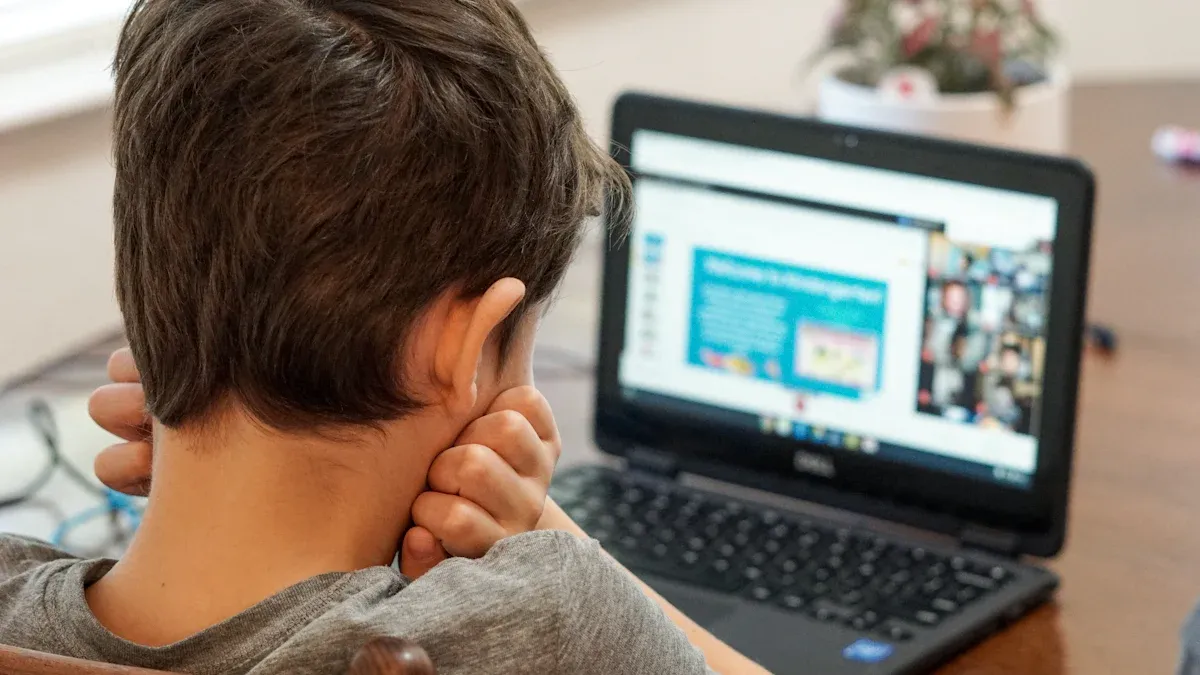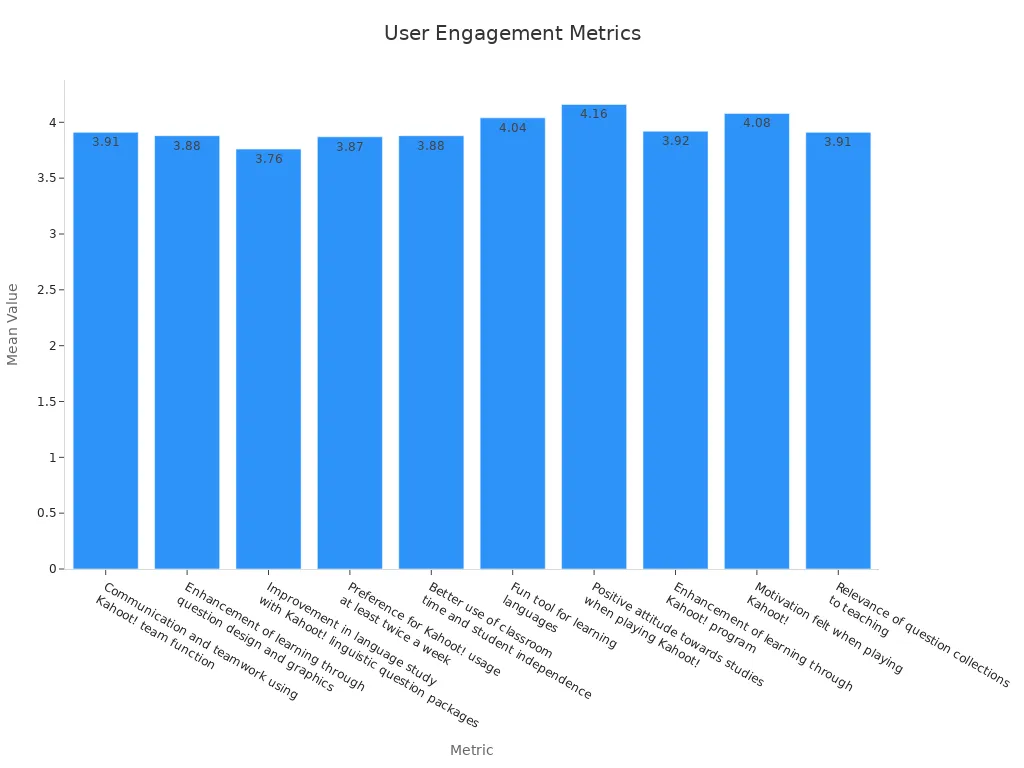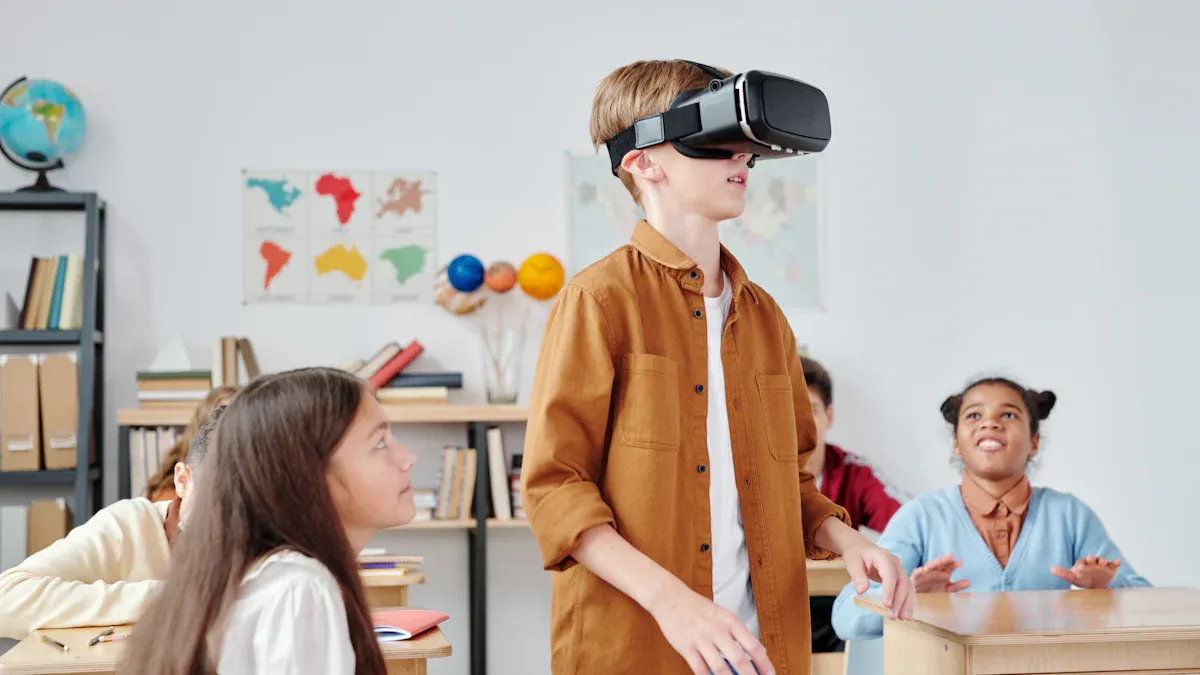
Technology has completely changed how you learn from a distance. It’s no longer just about video calls or online assignments. Tools powered by artificial intelligence are now identifying learning gaps and offering personalized recommendations. Virtual reality is making lessons immersive, letting you explore historical sites or conduct experiments from home.
Choosing the right tools is critical. Why? Because data-driven platforms can refine teaching methods, ensuring every student gets the support they need. Schools are using these insights to create interactive, engaging environments. So, which classroom technology solutions are best suited for distance learning? Let’s explore how these tools are shaping the future of education.
Use tools like Zoom and Microsoft Teams to talk and work together in online classes.
Try Google Classroom and Canvas to organize lessons and keep students interested.
Add fun tools like Jamboard and Kahoot! to make learning exciting and enjoyable.
When it comes to video conferencing, Zoom has become a household name. It’s easy to use, reliable, and packed with features that make online learning smooth. Whether you’re hosting a virtual class or breaking into smaller groups for discussions, Zoom has you covered. Its breakout rooms, screen sharing, and recording options make it a favorite among educators and students alike.
But what really sets Zoom apart? Its high user satisfaction ratings. Check out this comparison:
Metric | Zoom's Score | Industry Average |
|---|---|---|
Net Promoter Score (NPS) | 72 | 36 |
With a Net Promoter Score of 72, Zoom far exceeds the industry average of 36. This means users are not just satisfied—they’re enthusiastic about recommending it. If you’re looking for a tool that keeps your virtual classroom connected and engaged, Zoom is a top choice.
Microsoft Teams is more than just a video conferencing tool. It’s a complete collaboration platform. You can chat, share files, and even integrate apps—all in one place. This makes it perfect for group projects and ongoing discussions. Plus, its calendar feature helps you stay organized by keeping track of meetings and deadlines.
One of the best things about Teams is how it integrates with other Microsoft tools like Word, Excel, and PowerPoint. Imagine working on a group presentation where everyone can edit the slides in real time. That’s the kind of seamless collaboration Teams offers. It’s like having a virtual classroom where everything you need is just a click away.
If you’re wondering which classroom technology solutions are best suited for distance learning, both Zoom and Microsoft Teams deserve a spot on your list. They’re reliable, user-friendly, and designed to make online education more effective.
Google Classroom has become a go-to tool for teachers and students alike. It’s simple, intuitive, and designed to make online education feel less overwhelming. With just a few clicks, you can create assignments, share resources, and even provide feedback. Everything stays organized in one place, so you don’t have to dig through endless emails or folders.
The platform’s popularity skyrocketed during the COVID-19 pandemic. Schools worldwide turned to Google Classroom to keep learning on track. In fact, student engagement in remote learning increased by over 200 percent during this time. This shows how effective it can be in maintaining educational continuity. Plus, it’s free for schools, making it accessible to everyone.
If you’re looking for a tool that simplifies online education, Google Classroom is hard to beat. It’s perfect for managing your workload and staying connected with your students.
Canvas takes learning management to the next level. It’s packed with features that cater to both teachers and students. You can create courses, track progress, and even integrate third-party tools. Whether you’re teaching a small group or a large class, Canvas adapts to your needs.
What makes Canvas stand out? It’s been evaluated against 200 functional and technical requirements, earning high marks across the board. Faculty and students love it, and peer institutions often recommend it. This level of feedback shows how reliable and effective Canvas is as an LMS.
Canvas doesn’t just organize your courses—it enhances the entire learning experience. If you’re wondering which classroom technology solutions are best suited for distance learning, Canvas deserves a spot on your list.

Jamboard by Google is a fantastic tool for making your lessons more interactive. It’s a digital whiteboard that lets you and your students collaborate in real time. You can draw, write, and add sticky notes to brainstorm ideas or solve problems together. It’s like having a physical whiteboard, but with way more possibilities.
What makes Jamboard so useful? It’s simple to use and works on any device. Whether you’re using a tablet, laptop, or smartphone, you can join the session and contribute. Teachers love it because it encourages participation. Students can share their thoughts without feeling pressured to speak up in front of the whole class.
Here’s a tip: Use Jamboard for group activities. Divide your class into teams and assign each team a board. Watch as creativity flows and teamwork improves!
Creately is another excellent tool for visual learning. It’s perfect for creating diagrams, mind maps, and flowcharts. If you’re teaching a complex topic, Creately helps break it down into simple visuals that are easy to understand. You can even collaborate with your students to build these visuals together.
One standout feature of Creately is its vast library of templates. Whether you need a Venn diagram or a timeline, you’ll find a template to get started quickly. Plus, it integrates with tools like Google Drive and Microsoft Teams, making it easy to share your work.
If you’re wondering which classroom technology solutions are best suited for distance learning, tools like Jamboard and Creately should be on your radar. They make learning more engaging and help students grasp concepts faster.
If you want to make assessments fun and engaging, Kahoot! is the perfect tool. It turns quizzes into exciting games that students love. You can create custom quizzes or choose from thousands of pre-made ones. The platform’s colorful design and interactive features keep students motivated and eager to participate.
What makes Kahoot! so effective? It’s not just about fun—it’s about results. Studies show that using Kahoot! improves teamwork, motivation, and learning outcomes. Take a look at these user engagement metrics:
Metric Description | Mean Value |
|---|---|
4.16 | |
Motivation felt when playing Kahoot! | 4.08 |
Fun tool for learning languages | 4.04 |
Enhancement of learning through Kahoot! program | 3.92 |

These numbers prove that Kahoot! isn’t just a game—it’s a powerful learning tool. Whether you’re reviewing material or introducing new concepts, Kahoot! makes learning exciting and effective.
Edpuzzle takes video learning to the next level. It lets you embed questions, notes, and interactive elements directly into videos. This means students stay engaged while watching and actively think about the material. You can even track their progress and see how well they understand the content.
Why does Edpuzzle work so well? It combines visuals and guided questions to boost comprehension. Research shows that embedding interactive elements improves learning outcomes and reduces cognitive load. Here’s what makes Edpuzzle stand out:
Evidence Description | Key Findings |
|---|---|
Embedding guided questions and interactive elements | Supports positive learning outcomes and enhances student engagement. |
Use of visual aids | Reduces cognitive load, making learning more efficient by maximizing working memory capacity. |
Video characteristics | Significant impacts on learner attention, engagement, and outcomes through audio/visual cues and narrative styles. |
With Edpuzzle, you can turn passive video watching into an active learning experience. It’s a great way to ensure your students stay focused and truly understand the material.
Imagine having a tool that takes care of the tedious parts of lesson planning. That’s exactly what Brisk does. It’s like having a virtual assistant for your classroom. Brisk automates tasks like organizing lesson materials, scheduling activities, and even generating quizzes. This means you can focus more on teaching and less on prep work.
Why is Brisk so effective? It boosts engagement and transforms challenging subjects into exciting experiences. Teachers love how it simplifies their workflow, while students benefit from lessons that feel more organized and interactive.
Here’s how tools like Brisk enhance learning:
Transforms challenging subjects into exciting experiences.
Facilitates interactive teaching approaches through various digital tools.
Brisk isn’t just a time-saver—it’s a game-changer for creating dynamic and engaging classrooms.
If you’re looking for a way to make learning fun, Baamboozle is your answer. This platform turns lessons into lively games that students can’t get enough of. You can create quizzes, puzzles, and team challenges in minutes. The best part? It’s simple to use and works on any device with a web browser.
Baamboozle keeps things fresh with a variety of game formats. Whether you’re reviewing vocabulary or teaching math, there’s a game style to match your lesson. Plus, students don’t need accounts, so setup is quick and hassle-free.
Here’s why Baamboozle stands out:
Provides diverse game formats to keep students engaged.
Accessible on any device, ensuring everyone can join in.
Maintains privacy by not requiring student accounts.
With Baamboozle, learning feels less like work and more like play. It’s a fantastic way to keep your students entertained while reinforcing key concepts.

Imagine having a tool that understands how you learn best. That’s what SchoolAI does. It uses artificial intelligence to create personalized learning experiences just for you. If you’re struggling with a topic, it adjusts the material to match your pace. For example, if algebra feels overwhelming, SchoolAI starts with simpler problems and gradually increases the difficulty as you improve.
Here’s why this is a game-changer:
It adapts lessons based on your performance.
It provides content that helps you understand and remember better.
It ensures you get the support you need to succeed.
With SchoolAI, learning feels less like a one-size-fits-all approach and more like having a personal tutor. You’ll notice how much easier it is to stay motivated when the lessons are designed with you in mind.
Tip: Use SchoolAI to track your progress and see how far you’ve come. It’s a great way to stay inspired!
Taking notes can be messy, but NotebookLM makes it simple. This AI-powered tool organizes your notes and turns them into something useful. It analyzes your notes, highlights key points, and even answers questions based on the content. It’s like having a study buddy who’s always ready to help.
NotebookLM doesn’t just organize—it enhances your learning. By summarizing information and connecting ideas, it helps you understand complex topics faster. You’ll spend less time searching for answers and more time focusing on what matters.
With NotebookLM, your notes become a powerful resource. It’s perfect for staying on top of your studies and preparing for exams.
If you’re looking for a way to spark a love for reading in young learners, Epic! is the perfect tool. It’s a digital library designed just for kids, offering a safe, ad-free space to explore books. With over 40,000 titles, there’s something for every reader, whether they love adventure stories, science books, or fairy tales.
Epic! isn’t just about providing books—it’s about creating an engaging reading experience. The platform includes features like quizzes and badges to keep kids motivated. Parents love it too, with a 90% approval rating. Plus, Epic! adds 1,000 new books every month, so there’s always fresh content to discover.
Here’s a quick look at why Epic! stands out:
Engagement Metric | Value |
|---|---|
Number of Reading Quizzes | 300 |
Parental Approval Rating | 90% |
New Books Added Monthly | 1,000 |
With Epic!, you can turn screen time into learning time. It’s a fun and effective way to help kids build strong literacy skills while enjoying the magic of stories.
Writing can be tricky, but Quill makes it easier. This platform helps students improve their grammar, sentence structure, and overall writing skills. It starts with a diagnostic assessment to figure out where each student needs help. Then, it provides tailored activities to target those areas.
Quill’s approach is hands-on and interactive. Students practice grammar and proofreading through fun exercises. Teachers can also lead group writing activities, which encourage collaboration and teamwork. These methods align with Bloom’s Taxonomy, focusing on understanding and applying language rules.
Here’s what makes Quill so effective:
Offers personalized lessons based on student needs.
Includes grammar and sentence construction activities for deeper learning.
Encourages group work to build confidence and teamwork.
With Quill, writing becomes less intimidating and more enjoyable. It’s a great tool to help students express themselves clearly and confidently.
ElevenLabs is a game-changer when it comes to making learning accessible for everyone. This text-to-speech tool transforms written content into natural-sounding audio, helping students who struggle with reading or have visual impairments. Imagine being able to listen to your lessons while taking a walk or reviewing notes without staring at a screen. That’s the kind of flexibility ElevenLabs offers.
Assistive technologies like this are essential for creating inclusive classrooms. They ensure that students with disabilities have equal access to education. For example, text-to-speech tools allow visually impaired learners to engage with written materials, while Braille displays convert text into tactile formats. These tools don’t just help students keep up—they empower them to thrive.
Did you know? Accessibility has evolved into a core design principle in education. Tools like ElevenLabs align with Universal Design for Learning (UDL) principles, offering multiple ways to engage with content. This approach benefits all learners, not just those with disabilities.
Mizou is like having a personal assistant available 24/7. This chatbot answers questions, provides guidance, and even helps with troubleshooting tech issues. Whether you’re stuck on an assignment or need help navigating your learning platform, Mizou has your back.
What makes Mizou so effective? It uses data to understand student needs and improve engagement. By offering instant support, it reduces frustration and keeps you focused on learning. Plus, it’s always available, so you don’t have to wait for office hours to get help.
With tools like ElevenLabs and Mizou, distance learning becomes more inclusive and supportive. These technologies ensure that every student has the resources they need to succeed.
The tools you’ve explored here are reshaping distance learning in 2025. They personalize learning, boost engagement, and create immersive experiences.
Technology | Benefit |
|---|---|
AI Platforms | Tailored learning paths |
Virtual Reality | Interactive and immersive environments |
Engagement Tools | Improved comprehension and participation |
Adopting these tools helps you build dynamic classrooms. Start integrating them now to stay ahead and inspire your students!
Kahoot! is your go-to. It turns quizzes into fun games, keeping students engaged and motivated. Plus, it’s super easy to use!
Try Jamboard or Creately. Both tools let you brainstorm and create visuals with your students in real time. They’re perfect for teamwork!
Yes! Tools like ElevenLabs offer text-to-speech features, making learning accessible. Mizou chatbots also provide instant support, ensuring every student gets help when needed.